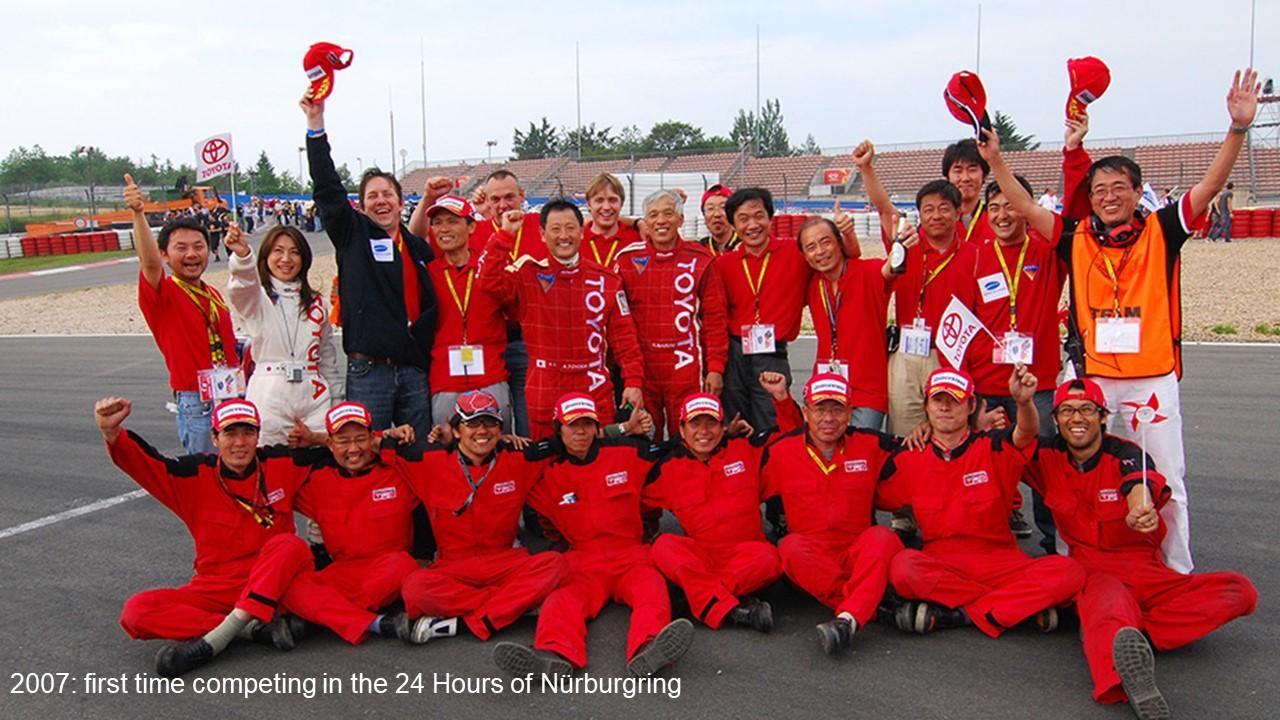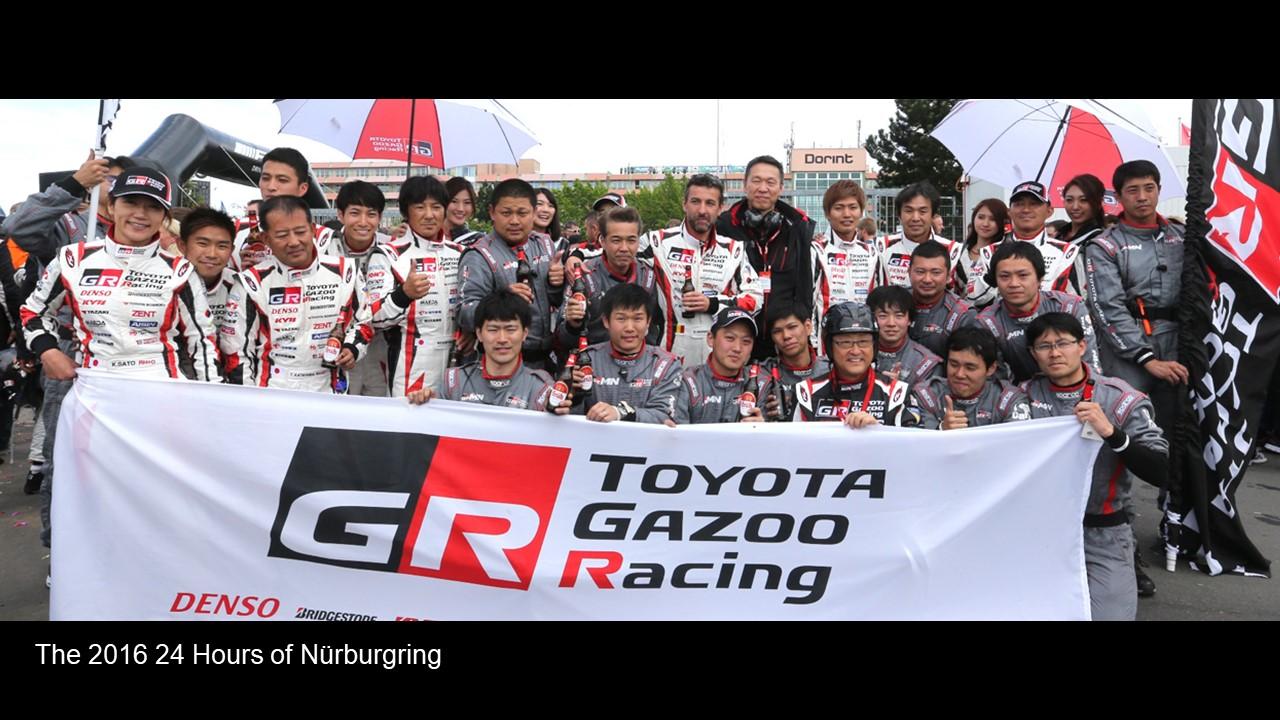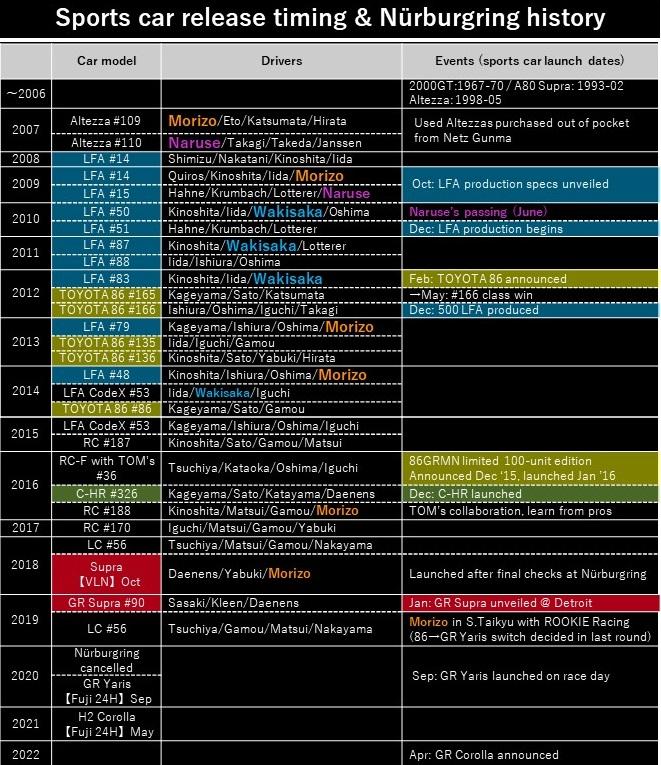Breaking down the history of Toyota's first Nürburgring 24-hour race, its lessons for today, and the resulting vision for the future.
After describing how Toyota’s Nürburgring challenge started in part one, here we move on to look back on the journey over the last 15 years.
[Pre-2007] Driver training in out-of-production Supras
In 2007, then-Executive Vice President Akio Toyoda had his first taste of racing in the 24 Hours of Nürburgring. In preparation, he had climbed behind the wheel to practice driving under Toyota’s master driver, Hiromu Naruse whenever possible.
Their training car was an A80 Supra. The Nürburgring course was made available exclusively for manufacturer testing on certain days, and that’s when Akio and Naruse conducted practice sessions. Whereas other manufacturers ran disguised prototype vehicles, the Toyota pair used an old model already out of production.
At the time, Toyota wasn’t producing a sports car fit for driver training at the Ring. Other manufacturers, meanwhile, would test their latest sports cars under development for future release. Akio suffered the humiliation of being the only team forced to drive a car no longer even found at dealerships, despite Toyota’s global market presence.
To him, every car that flew past seemed to be saying, “Toyota could never make a machine like this.” Though thrilled to be driving the Nürburgring, he could not help but feel frustrated as the others streaked ahead.
The sense of frustration pushed Morizo to keep striving toward the 24 Hours of Nürburgring. This period proved crucial in forming the fundamental car-making mindset that still defines Toyota today.
[2007-2009] An incognito first attempt
Akio’s team first entered the race in 2007 with two second-hand Altezzas purchased from Netz Gunma and modified for racing. Unable to use the Toyota name, they borrowed “GAZOO” from a project Akio was leading at the time.
Many people saw the Nürburgring challenge as the Toyota heir’s personal amusement. Even within Toyota, it was poorly understood and met with a lukewarm response. The project was overlooked in terms of budget and personnel, ending up mostly self-funded. Akio himself had no choice but to lie low, appearing under the driver name Morizo, borrowed from the official mascot of the 2005 Aichi World Expo.

At the time, Toyota focused its motorsport efforts on Formula 1. Although every F1 component was made to the highest precision, the associated cost and technical level pushed them out of reach for production cars. What Naruse and Morizo aimed for was motorsport activities more closely linked to the development of ordinary cars.
[2007-2009] The importance of keeping traditions alive
In manufacturing, the transfer of skills and technologies to younger generations can be likened to Ise Jingu’s Shikinen Sengu ceremony, in which the grand shrine is completely rebuilt every 20 years. Some believe the ritual is performed not only to rejuvenate aging buildings, but also to pass on architectural techniques.
Any sports car worth the name elevates the key functions of a car—accelerating, turning, and braking. Therefore, by building such vehicles, people can master the skills and technologies for making ordinary cars.
The same person who works on a given car as a young recruit in their 20s will, two decades later, play a central role in developing cars and nurturing the next generation. Another 20 years on, they will be the master through whom knowledge and skills are passed on.
At the time, 15 years had already passed since Toyota’s last sports car release with the A80 Supra. Naruse and Morizo feared that this cycle, originating from the world-renowned Toyota 2000GT launched in 1967, might be broken.
Despite little support from the company, the pair continued to push forward with purposeful passion and action. Their determination drew in other like-minded individuals, helping the team finally reach the Nürburgring.
These efforts also drove progress on Toyota’s new sports car project, the LFA, which ran at Nürburgring the following year in 2008. A production version of the LFA was revealed in October 2009.
[2010-2011] Carrying forward a mentor’s vision
In 2010, seeking a Nürburgring victory for the in-production LFA, the team welcomed Wakisaka and other professional drivers. Then on June 23, one month from the 24 Hours of Nürburgring, tragedy struck.
This happened to be the day of Toyota’s General Shareholders' Meeting, the first chaired by President Akio Toyoda. In the early hours of the morning, he was informed of Naruse’s death in an accident at Nürburgring. While out testing the LFA on a public road, the master driver had collided with an oncoming car.
Known for being exacting when it came to cars, Naruse nonetheless gave the LFA his highest praise: “This car can conquer any road, any car. All those years of hard work have paid off. I knew this car would not betray all that we have poured into it.” Sadly, he never got to see LFA production cars out on the roads.
One can only imagine how Morizo felt at that time. In his eulogy at Naruse’s funeral, he shared the following.
Akio Toyoda (eulogy for Hiromu Naruse)
Whether spending time driving on the track with Naruse-san or just speaking with him, his passion to “share and spread the fun of driving to future generations” has become – and will remain – the source of what I do and say.
Naruse-san said, “There is no end to ‘making better cars.” Those of us left behind are determined to carry on and push forward his passion and the path he has created. We promise you, we will make ever-better cars.
Thank you for everything, Naruse-san. May you rest in peace and watch over us from heaven.
(This is an excerpt. Read the full text here.)
The following year, Toyota continued to take on the Nürburgring just as Naruse had wished. Two trees were planted near the site of the accident in his memory, one a Japanese sakura, the other a German cherry. To this day, team members arriving at Nürburgring visit the location to pay their respects, carrying Naruse’s vision into the future.
[2012-2014] Growing talent leads to better cars
In 2012, the Toyota 86 just announced that February entered the Ring 24-hour race. The 86 continued to be raced and honed on the grueling Nürburgring roads even after launch.
The skills and technologies gained in the process were channeled into the new 86 GRMN model released in December 2015. Morizo’s joy at finally releasing a vehicle built on the Nürburgring roads was shared by everyone involved.
“Our people had grown to the point where we could finally make such a car,” says Wakisaka of this period. While vehicle development was certainly part of the Nürburgring endeavor, the greater motivation was developing people. The project had fostered the next generation of staff mechanics, test drivers, and other talent.
Toyota had finally managed to bring cars forged on Nürburgring roads out into the world. And yet, the journey was far from over. The new model had a limited production run. Morizo and the GAZOO Racing crew were clearly moving in the right direction, but found themselves facing a new source of frustration.
This only set the team’s sights more firmly on the future. With no definitive answers on the horizon, they continued to discuss and work through each of the challenges that troubled them, in the process of paving a clear path forward.
[2015-2017] Outside pros inspire further learning
In 2015, the company’s various racing activities were brought together under the umbrella of TOYOTA GAZOO Racing (TGR). The following year, Morizo’s team reached its milestone tenth attempt at the 24 Hours of Nürburgring.
Photos taken after that 2016 race capture the team’s family-like atmosphere. Morizo can be seen donning the helmet of a mechanic who missed out on the main event due to a sudden illness. Every teammate who had devoted the past year to car development was there in spirit, if not in person.

In that same year, TGR also attracted attention for fielding a C-HR instead of a sports car. The SUV’s appearance at Nürburgring showed the world how profoundly Toyota had changed its approach to making cars.
Another new venture was TGR’s collaboration with TOM’s, a professional racing outfit. Up to that point, Toyota employees had taken on the role of mechanics, but in this instance, professionals were also brought in to work jointly on the car. This move provided a chance to learn new skills and perspectives, contributing to the talent development, a Nürburgring project’s unwavering purpose.
“This approach was the reverse of what ROOKIE Racing currently does, but the end results are interconnected,” explains Yuki Imai, a motorsports journalist. Today, Toyota employees are loaned to ROOKIE Racing to work alongside professional mechanics, but the idea of learning from outside experts remains the same.
[2018-2019] Tears flow anew on June 23
In 2018, Toyota made steady progress on the new GR Supra. Ahead of its official launch, in November the car was tested in the heat of battle at Round 9 of the VLN Endurance Championship Nürburgring.
Morizo and two other Naruse proteges piloted a camouflage-pattern car they dubbed the “A90.” In that moment, the team finally realized their long-held dream of racing at the Nürburgring as part of development.
Upon finishing a trouble-free race, Morizo told the development team, “It's so incredibly fun to drive.”
The GR Supra was unveiled to the world at Detroit Auto Show the following January. Six months later, it ran in the 24 Hours of Nürburgring, this time under its real name. After Morizo’s early days driving a used Supra, the car had come full circle, honed on the grueling Nürburgring course before returning as a regular feature of the Toyota lineup.
Then on June 23, 2019, exactly nine years from the tragic loss of his cherished mentor, Morizo shared these comments after completing the 24-hour race.
Morizo (post-race comments)
To begin with, let me say thank you to everyone involved. Today is the anniversary of Naruse’s death.
I drove my third stint from 10 o’clock, but it was initially planned to be from 9 o’clock. I realized that it happened to be around the same time that Naruse suddenly passed away.
Gripping the steering wheel at the time Naruse died… I was extremely nervous. Many things came to mind when I was driving this third stint—entering the 13th year of competing in this race with this car, the Supra—and to be honest, I was in no real state to drive.
I’d like to think Naruse is listening to us as we discuss all this now.
At the time of his funeral, I resolved to stay on this path alongside a handful of passionate people who wanted to continue doing this with me. This was how our GR activities began. Now, the GR project has the support of so many people and is at the very center of our efforts to make ever-better cars, and to improve our people.
Truly, I want to thank everyone who has supported these efforts so far. When speaking about Naruse, I can’t hold back my tears. The reason is disappointment.
Thirteen years ago, we could not even use the Toyota name; our team comprised basically two people—Naruse and myself—and we participated in the 24 Hours of Nürburgring with a homegrown team with fewer members than most privateer teams.
Back then, I was overcome by various disappointments—the disappointment of not receiving any support; the disappointment of not being taken seriously, no matter what we did; the disappointment of being belittled, no matter what we did; and the disappointment of having to run a Supra model that was no longer in production.
I was appointed president on June 23, 2009, and ever since Naruse passed away, exactly one year later on June 23, 2010, all these disappointments have remained with me continually.
These disappointments are why all I do is repeat the mantra “let us make ever-better cars.”
Even today, I still feel regret and shed tears. These disappointments have been a source of our strength, pushing us to create like-minded companions sharing the same goal, and to make ever-better cars. These thoughts were on my mind when I started by thanking you all today.
I drove four stints, including the start and finish, but I think Yabuki (who has been in charge of the GR Supra development) was the one who should have driven the car today. If today were not such a special day, I would have asked Yabuki to drive the Supra.
However, due to the three key elements of June 23, the Supra, and the Nürburgring, I felt as if Naruse was telling me, “No, you should drive. We can drive together!”
I’m certain that Naruse is listening to us today, and I believe he may have brought us this nice weather. As a driver, no doubt I proved a hindrance to my teammates, but the other three professional drivers covered for me exceptionally well. Thank you!
[2020] From Nürburgring to Fuji 24 Hours
Disappointment and frustration seem to have bolstered Toyota, culminating in the making of ever-better cars. And yet those sentiments still lingered. Part of the reason was that the 86 and GR Supra were both made in collaboration with other companies; Toyota could not fully claim these cars as the work of their own hands.
Toyota’s next goal was to build its own sports car from the ground up. That car was the GR Yaris, launched in 2020. Under normal circumstances, it’s likely that this model too would have been developed at the Nürburgring and entered in the 24-hour race.
With the outbreak and spread of COVID-19, competing in the event became unfeasible.
Meanwhile, Morizo had relocated his driving activities from TGR to ROOKIE Racing, a team he personally established and owns. ROOKIE Racing began to compete in Japan’s endurance racing series, Super Taikyu, with plans to field the in-development GR Yaris from 2020.
Unfortunately, it proved difficult to get the motorsport season underway amid pandemic-related restrictions. When racing eventually resumed in the fall, Morizo’s team was thrown straight into the deep end with a debut at Fuji 24 Hours. As it happened, race day coincided with the GR Yaris’s launch. This strange twist of fate meant that on the same day it was released to the public, the GR Yaris was also making its first competitive appearance in a 24-hour endurance race.
The GR Yaris finished first in its class, despite being a new model with no race experience. Wakisaka recalls being stunned by the result. Yet the victory was no fluke—it no doubt stemmed from Morizo’s continued efforts, even under COVID restrictions, to test and further improve the Yaris on Toyota’s private dirt course.
Just when it seemed that Toyota’s endurance racing challenge would be put on pause by the pandemic, the team remained committed to ensuring that its mechanics could continue their Nürburgring work in the Super Taikyu. And so the journey proceeded uninterrupted.
[2021- ] Car-making sheds light on the future
In the second half of 2020, the automotive industry was grappling with a profound challenge—the pursuit of carbon neutrality. Morizo drove a prototype equipped with a hydrogen-powered engine late that year. He was joined on board by Kamui Kobayashi, and the ensuing conversation led to a decision to cast the new engine into the motorsport arena.
The problem was that only four months stood between that decision and the Fuji 24 Hours. Toyota’s team had no choice but to move fast with development. In this way, the motorsport-led approach to making ever-better cars continues to deliver exciting advances despite facing all kinds of adversity.
“It’s fair to say that Toyota’s actions affect the wider economy and the country,” says Wakisaka. “Within that, I believe Morizo has returned to the fundamentals of car-making and rediscovered that Toyota’s endeavors can shed light on our future, which he is sharing with us.”
An unwavering genba-driven approach to making ever-better cars
Although TGR was already thriving, Morizo set up a private team, ROOKIE Racing, where he now does his driving. Why make the move?
Wakisaka admits that, initially, he didn’t really understand it. Recalling what he heard at the time, Wakisaka responded, “He did it because he’s still fighting to restore Toyota.”
Morizo established GAZOO Racing to return Toyota to its origins as a genuine car-maker that builds quality vehicles for customers’ enjoyment. There, he personally climbed behind the wheel to change the company from outside.
This venture morphed into a vast corporate entity, a factory-backed team capable of taking on world-class competitions like the WRC. At TGR, Morizo undeniably stood as the company president. ROOKIE Racing, on the other hand, offered a way to get closer to the frontlines and to obtain a true genba perspective for reforming Toyota’s car making.
“Whether it’s TGR or ROOKIE Racing, Morizo’s mindset is unwavering,” says Imai. “It certainly makes you want to get behind him and entrust him with our future.”
“Motorsports have shaped our lives, so we want to give something back,” added Wakisaka. “We plan to spend our lives thinking about what motorsports can do for the auto industry. More than anything, having Morizo there with us is a source of strength.”
The ongoing journey of making ever-better cars through motorsports has woven together the ambitions of the late Hiromu Naruse, Morizo, and countless drivers, mechanics, engineers, fans, and collaborators. Embracing that history, the latest chapter is set to start with the Fuji 24 Hours.


